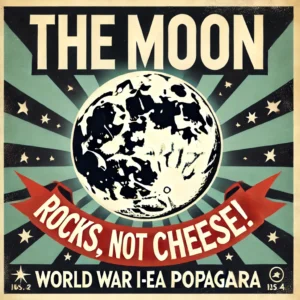The idea that the moon is made of cheese has been a whimsical and enduring myth for centuries. This playful notion, while clearly fictional, has found its way into various cultural references, children’s stories, and even early scientific speculations. The concept likely originates from medieval fables and folklore, where the ‘green cheese’ reference was used metaphorically to describe something that was freshly made or unripe, rather than actual dairy cheese. Over time, this idea evolved into the amusing belief that the moon might actually be made of cheese, an idea that has persisted in popular culture even into modern times.
Historical Context: The Origins of the Cheese Moon Myth
The ‘moon made of cheese’ myth can be traced back to various cultural and literary sources. The earliest recorded use of the phrase ‘the moon is made of green cheese’ comes from John Heywood’s *Proverbs*, published in 1546. In this context, ‘green cheese’ referred to a fresh, unaged cheese, and the phrase was used metaphorically to imply gullibility or naivety, suggesting that someone who believed such a thing was easily deceived.
Scientific Analysis of Moon Rocks
The most compelling evidence against the moon being made of cheese comes from the analysis of lunar rocks brought back to Earth by the Apollo missions. Between 1969 and 1972, astronauts from the Apollo missions collected and returned over 380 kilograms (840 pounds) of lunar rocks, soil, and core samples to Earth. These samples have been extensively analyzed by scientists worldwide, revealing that the moon is composed primarily of silicate minerals such as basalt and anorthosite. These materials are characteristic of a rocky body, fundamentally different from any organic material like milk or cheese.
Astronomical Observations and Spectroscopy
Modern astronomical techniques, such as spectroscopy, have further debunked the cheese myth. Spectroscopy involves analyzing the light reflected off the moon’s surface to determine its chemical composition. The spectra obtained from the moon’s surface show that it consists of oxygen, silicon, magnesium, iron, calcium, and aluminum, along with other trace elements. These findings are consistent with the composition of terrestrial rocks and not with any organic substances like cheese.
Lunar Surface Exploration and Geology
The Apollo missions, along with unmanned missions such as the Soviet Luna and American Surveyor programs, provided detailed data about the moon’s surface. Photographs, physical data, and direct human interaction with the lunar surface all confirm that the moon is a rocky body. The numerous impact craters on the moon also provide evidence of its solid, rocky composition. The formation and structure of these craters are consistent with impacts on a rocky surface, which would not be the case if the moon were made of a soft material like cheese.

Conclusion: A Fun Myth with a Scientific Explanation
While the idea that the moon is made of cheese remains a humorous and popular myth, scientific evidence has thoroughly disproven this notion. Through the analysis of lunar samples, spectroscopy, and direct exploration, we know that the moon is composed of rock and minerals, not cheese. This understanding highlights the value of scientific exploration and the importance of distinguishing between myth and reality in our understanding of the universe.